Menus
- Small single-cylinder travel enduro
- 860 millimeters seat height
- Coupling is easy and can be dosed adequately
- Driving behavior, series tires, ergonomics
- ABS can be deactivated with a switch
- MOTORCYCLE conclusion
- Information on the G 310 modular system
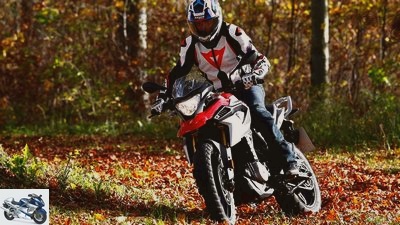
factstudio.de

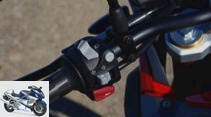


17th photos
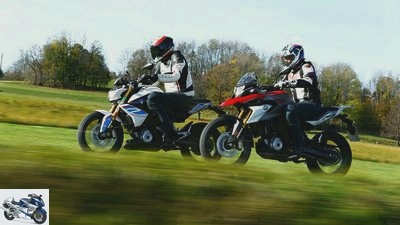
factstudio.de
1/17
Top test BMW G 310 GS / R.
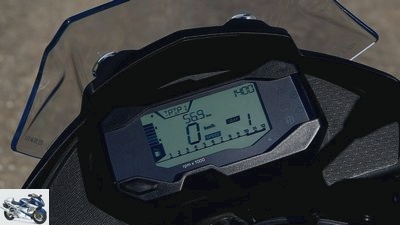
factstudio.de
2/17
High contrast, easy to read, sober, but informative – the cockpit is similar to the G 310 R..

factstudio.de
3/17
At the push of a button, the ABS can be easily deactivated for excursions away from the paved roads.
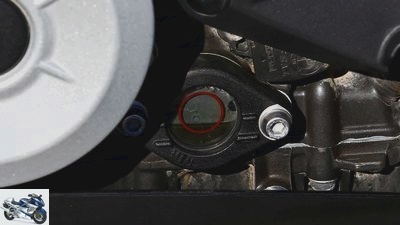
factstudio.de
4/17
Always practical: oil level check at a glance via the sight glass on the left.
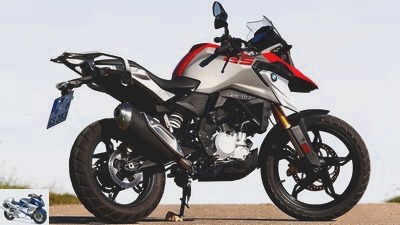
factstudio.de
5/17
Lots of wheels, manageable engine: the dimensions of the G 310 GS are fully grown. The twisted single cylinder with a nominal 34 hp and 28 Nm is located in the tubular space frame.
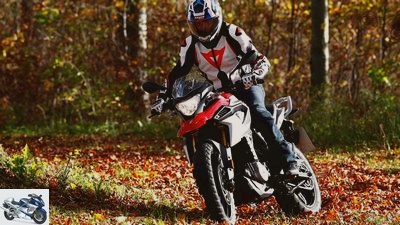
factstudio.de
6/17
Wood and gravel deposits are possible thanks to 180 mm of travel, 19 inches at the front and a reasonable weight.

factstudio.de
7/17
Front inlet, rear outlet, cylinder tilted backwards – high-tech from India.
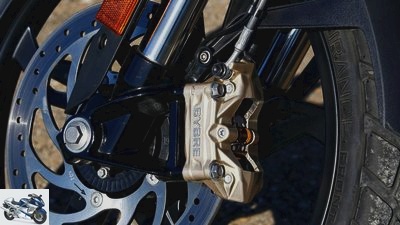
factstudio.de
8/17
The Indian Brembo subsidiary supplies the brakes. Only sufficient despite steel flex and sintered metal.

factstudio.de
9/17
Note the weld seam as a quality indicator: solid in a positive sense.

factstudio.de
10/17
Driving pleasure is also possible without a lot of power: impeccable cornering behavior on the G 310 GS.
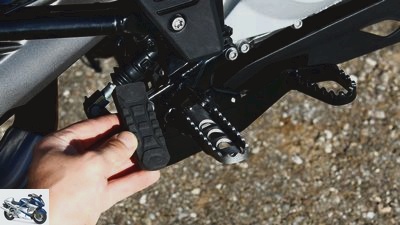
factstudio.de
11/17
Footrest pad: A rubber block is attached to the non-slip enduro footpegs and removed in next to no time.
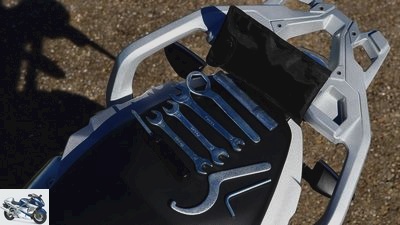
factstudio.de
12/17
Tool kit: There is a decent package of tools on board. This can be used to tension the chain and adjust the spring preload.
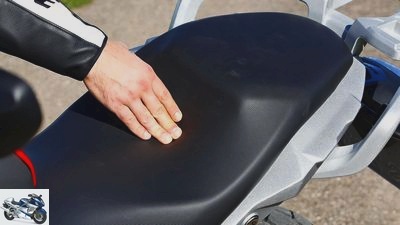
factstudio.de
13/17
Seat cover: The bench is quite well padded, but the cover on the driver’s rear is “hollow”. Whether that stays tight for a long time?
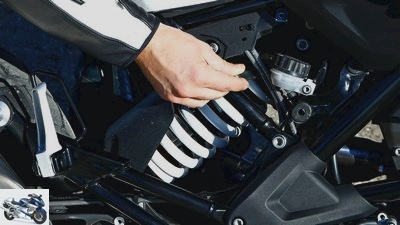
factstudio.de
14/17
Spring preload: There is a tool, but a side cover must be removed to adjust the preload, the spring base is difficult to access.
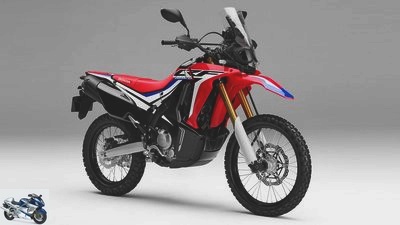
Honda
15/17
The competition: Honda CRF 250 Rally.
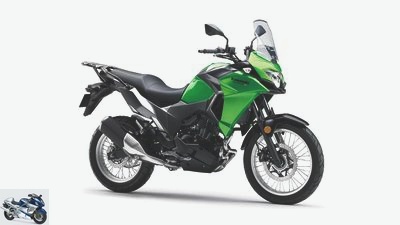
Kawasaki
16/17
The competition: Kawasaki Versys X 300.
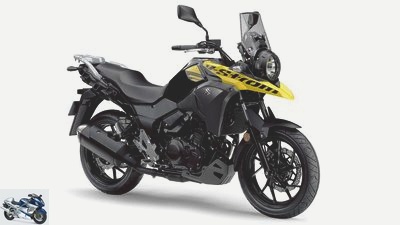
Suzuki
17/17
The competition: Suzuki V-Strom DL 250.
BMW G 310 GS in the top test
Small single-cylinder travel enduro
BMW is expanding the young G series, providing the G 310 R roadster with a long-legged, technically closely related G 310 GS. Certainly a promising tactic for the world market. But how does a 313-cubic single-cylinder “travel enduro” fare in the local area? Top test with 34 hp!
In the case of BMW, there is some background information beforehand G 310 GS unavoidable: BMW is known to lead the German market, the R 1200 GS, R and nineT and the like are also selling excellently across Europe. Globally, however, such prestige bikes with over 100 hp play practically no role. In the enormously fast-growing emerging markets of Asia, India and South America, the Hondas, Heros, Bajajs and Shinerays have been sharing the very, very big cake among themselves with inexpensive, robust everyday machines up to 300 cubic meters. As part of the expansion strategy issued by BMW, the new, large G-series has been intended to carry the white-blue premium propeller into these promising markets since 2016. Because this cannot be achieved with a roadster in the style of the G 310 R alone, the BMW G 310 GS is accompanied by a “travel enduro”. A big name for a small machine in this country.
Buy complete article
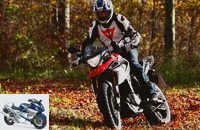
BMW G 310 GS in the top test
Small single-cylinder travel enduro
Luggage rack as standard on the BMW G 310 GS
Also manufactured by the Indian cooperation partner TVS in Bangalore, the small BMW G 310 GS shares its modular system with the G 310 R: a modern 313 cubic single cylinder (rotated installation position with inlet at the front, cylinder tilted backwards, four-valve technology, DLC- coated rocker arm, nicasil-coated cylinder), tubular space frame, comparatively long cast aluminum swing arm, upside-down fork. So the list of design features reads considerably for a motorcycle that is in the showroom in Germany at a base price of 5,800 euros. On top of that, the G 310 lures as a GS with its concept-based utility value: Extended spring travel (front and rear now 180 instead of 130 or 140 millimeters) and a 19-inch front wheel promise superior ride comfort, the highly adult dimensions of comfortable space and at the rear there is a standard Luggage rack. Exactly the right thing for the tough everyday use in places with exotic names and with less well-developed road networks. And maybe with us too, for the daily commute to the office and occasional gravel trips?
860 millimeters seat height
At least that’s the theory. However, the following consideration must also be included in this: The 313 single-cylinder of the BMW G 310 GS with a maximum of 34 hp leaves a significant gap to the 48 horses permitted in the A2 class, and in terms of performance it lags behind the sometimes significantly stronger, only slightly more expensive ones Competitor. And so it sits, at least when looking at the key data, something special in the local market environment. On the other hand, the G 310 R, which is part of this top test as a reference, was able to largely dispel precisely these concerns with refreshingly playful, lively driving behavior and a completely coherent conception. So then to practice.
And it starts with the fitting: the seat height of the BMW G 310 GS is 860 millimeters instead of the 790 on the Roadster. This is not very low and so excludes the smallest of the little ones, despite the narrow crotch tank and an acceptable step length. Pilots under 1.70 meters will find a lower 820 millimeter bench seat as an accessory at a price of 247 euros. Once you have boarded the standard bench, the result is rather high, but combined travel enduro ergonomics. That means: a nice open knee angle (although very tall drivers complain that the tank flanks spread their legs wide, which makes it difficult to reach the brake and gear lever), a handlebar that is not excessively wide and is moved close to the driver, and thus a perfectly straight, upright seat. position. From this perspective, too, the dimensions of the BMW G 310 GS appear anything but small. An impression that shouldn’t put off beginners, provided they have the necessary minimum body length. Because at 173 kilograms the 310 was not sensationally light for such a motorcycle. In absolute terms, however, the Baby-GS is very tame thanks to a rather low center of gravity when maneuvering and stopping at traffic lights.
Coupling is easy and can be dosed adequately
Starting. The single cylinder of the BMW G 310 GS starts up modestly, only lapsing into a slightly increased idle speed after cold nights. When the clutch is disengaged, the engine also runs a little more idle. A peculiarity that you already know from the G 310 R, but that hardly bothers you. The single’s throttle response is very successful, practically perfect. The four-valve engine hangs calmly and yet with verve on the gas. The latter is primarily due to a very low centrifugal mass – that in turn requires a lot of gas and sensitive coupling when rolling off, otherwise – plop! – a restart is required. The coupling’s strengths are great ease of movement and reasonable controllability. However, she is less fond of sharp starting, as required by the measurement of acceleration, or heroic deeds in the city center. Then she kneels a little, screeches shrilly, loses the defined grinding point.
factstudio.de
High contrast, easy to read, sober, but informative – the cockpit is similar to the G 310 R..
In general, the 310 of the BMW G 310 GS, which is also known from the Roadster sister, requires a dedicated, folding right wrist for quick progress. Around the bottom the engine runs with little vibration, but not exactly as strong as a bear; at 4,500 revolutions, for example, 15 hp are applied to the crankshaft. In addition, power and torque increase significantly in undulating motion, but with them also disturbing vibrations occur. Despite the balancer shaft, the drive tingles through footrests and handlebar ends, which irritates in the long run.
In the G 310 Roadster, this engine fits really well with its revving, the grumpy sound and the crisp, short gear ratio, as it spreads a “knife between the teeth” mood and joie de vivre. In a concept like the more upright, more dignified, at least tendentially long-distance suitable BMW G 310 GS, however, the lack of torque and sovereignty become evident. The full eleven kilograms of extra weight are noticeable when accelerating, and the much larger frontal area (which, however, offers better wind and weather protection) also brakes noticeably towards the identical top speed of at least 153 kilometers per hour. It’s like this: the engine is fine on its own, if you come from the A1, you won’t want anything. However, the subliminal expectations with which the test team and with it presumably everyone except absolute newcomers approach a machine on which “GS” is written in large letters, is what he has to bear. Subjectively, and the measurement data prove this, the G 310 R seems hungry, the BMW G 310 GS strained. What can also be seen from the slightly increased fuel consumption: While the R only consumes 3.0 liters per 100 kilometers on a fuel-consumption trip, the GS is 3.3. Which in itself is of course still a very good value.
Driving behavior, series tires, ergonomics
This was also noticeable with the G 310 R: The G-drive has short shift travel and engages accurately, but shifts dry to bony. The idle search requires patience and a sensitive shift toe. The best thing to do is to find neutral still rolling easily, while standing this is often difficult, presumably due to a clutch that does not separate properly. However, this situation improved significantly with the G 310 R long-term tester as well as with the BMW G 310 GS over the approximately 2,000 kilometers test distance with increasing mileage.
The BMW G 310 GS is far more compatible with the high demands of the Federal Republic of Germany when it comes to driving behavior. Although it sacrifices some of the unconditional handiness of its 17-inch model sister model with tires, it replaces it with a second serenity in return. This highly trustworthy, stable cornering behavior flatters beginners as well as advanced. The large 19-inch front wheel is always present in the form of smooth, smooth turning. The BMW G 310 GS is not familiar with sudden folding down or tilting in an inclined position, as can sometimes be found in the smallest class. It is very easy and pleasantly intuitive to drive, and its freedom from lean angles is enormous. To avoid misunderstandings: The less handiness is due to the direct comparison with the ultra-fast G 310 R. Taken on its own, or compared to the current next-largest, the F 700 GS, the 310 naturally wags like the proverbial bicycle.
The decent initial tires make a significant contribution to the pleasant driving behavior. The “Metzeler Tourance”, baked in Brazil, adheres reliably even on damp surfaces, does not even begin to stand up on the brakes, and should at most offer a little more feedback. The coordination of the suspension elements also fits in nicely with the concept: soft, but not too soft, the USD fork and shock absorber spring and dampen sufficiently creamy. In conjunction with the long suspension travel, this creates an enormous level of comfort that you would not have expected of a motorcycle in this class. The rear shock absorber is barely preloaded at the factory, and sports fans are recommended to adjust it towards maximum preload. But that doesn’t change anything about the fundamentally soft character of the GS. Together with the successful chassis geometry and balance, the BMW G 310 GS also enables enjoyable excursions on gravel or forest paths, although the handlebars should be turned a little forwards for driving while standing. The footpegs made a positive impression. A thick, slightly anti-vibration rubber pad conceals non-slip, jagged metal, and removing this plugged pad also opens the knee angle a little wider.
ABS can be deactivated with a switch
It is also pleasing that the ABS on the BMW G 310 GS can be conveniently deactivated for such small off-road activities using a switch on the left end of the handlebar. However, there is potential for optimization in the deceleration apparatus itself. The front 300 mm disc is applied with braking pressure by a four-piston radial caliper from the Indian Brembo subsidiary Bybre, but the pressure point is wooden despite sintered metal linings and flexible steel tubing. The required manual force is too high, the brake is a bit blunt. The ABS has been given a more defensive set-up, which, together with a deeply submerged front, creates a braking distance that is too long even for the cheap class. This is due to the requirements of the world market and works better.
On closer inspection, the processing of the BMW G 310 GS, like that of the G 310 R, proves to be at least appropriate for the price, and in parts even above the class standard. Attractive weld seams, neat paintwork, cleverly laid cables – eyes and hands don’t get caught anywhere. The MOTORRAD endurance test of the G 310 R must and will show what the durability of the machine is (technical difficulties or quality problems delayed the market launch of the G 310 R).
MOTORCYCLE conclusion
Attractive driving behavior, great comfort, high suitability for everyday use, low maintenance costs – that speaks for the BMW G 310 GS, especially from the perspective of novice drivers and commuters. Those, and probably only those, will be satisfied with the somewhat lost-looking 313 cubic single-cylinder. While this drive fits the roadster perfectly, it lacks torque in a full-fledged motorcycle like the GS. In Brazil you will probably disagree, but a handful of Newton meters more and, while we’re at it, perhaps a handful of kilos less would look good on the G 310 GS. G 450 GS, anyone?
Information on the G 310 modular system
It costs a lot of money to build a new motorcycle, to make it again. The modular system helps to save: Identical parts only have to be developed once, higher quantities also mean lower individual unit costs. This is how the G 310 R becomes a GS.
factstudio.de
The small travel enduro BMW G 310 GS and the roadster BMW G 310 R share the modular base..
The G 310 GS and G 310 R share a lot of technology: the engine, swing arm and brakes are taken over directly, and the frame is largely the same. In addition to the changed fastening points for the fairing, the control head was adapted. The steering head angle is now 63.3 degrees, which is flatter instead of 64.9, and a forward axle mount helps to reduce caster from 102 to 98 mm. The front wheel now measures 19 inches, while the rear remains with the 17-inch model. Also the same: cockpit, headlights, many small parts (such as mirrors) and even the seat. The main difference besides the front wheel: spring travel extended to 180 millimeters.
Related articles
-
Top test Yamaha BT 1100 Bulldog
Bilski Top-Test Yamaha BT 1100 Bulldog Dog Days This year the dog days are late ?? at least for motorcyclists. Because the Yamaha BT 1100 …
-
Test MuZ Baghira ascending trend The brand new MuZ Baghira is beautifully colorful. And what else does the sporty enduro have to offer?? How do you think…
-
Husqvarna TR 650 Terra, KTM 690 Enduro R and Yamaha XT 660 R in the test
Jahn 22 pictures Jahn 1/22 Husqvarna TR 650 Terra, KTM 690 Enduro R and Yamaha XT 660 R in the enduro everyday comparison test. Jahn 2/22 Husqvarna TR 650 Terra ….
-
24 pictures Triumph 1/24 Triumph Tiger 800: The three-cylinder engine generates 95 hp at 9300 rpm from 799 cubic meters. Triumph 2/24 Triumph Tiger 800 XC …
-
Double top test BMW R 1200 GS-R 1150 GS
fact double top test BMW R 1200 GS / R 1150 GS Beautiful view Cheeky to whet corners, dust quickly through the terrain, travel comfortably, arrive safely …
-
Triumph Legend TT test Simple and poignant Lower, handier, cheaper. The new Triumph Legend TT aims to make entry into the three-cylinder world easy….
-
Gagolov Top-Test MV Agusta F4 S The art of the round It is in a prominent position in a world-famous art exhibition. And she provides her own …
-
Jahn Top test KTM 640 LC4 Still crazy In the past 14 years, the LC4 evolved into today’s 640. What was left of the former off-road athlete? Are the wild…
-
Top test Harley-Davidson VRSCA V-Rod
fact Top test Harley-Davidson VRSCA V-Rod Emotional rescue Words are missing. At least the Germans. Because just at the time when the rest of the…
-
Gargolov Top-Test Yamaha XT 660 R Still single? The abbreviation XT has stood for adventure and pack mule for decades. Now the new one is here. With…